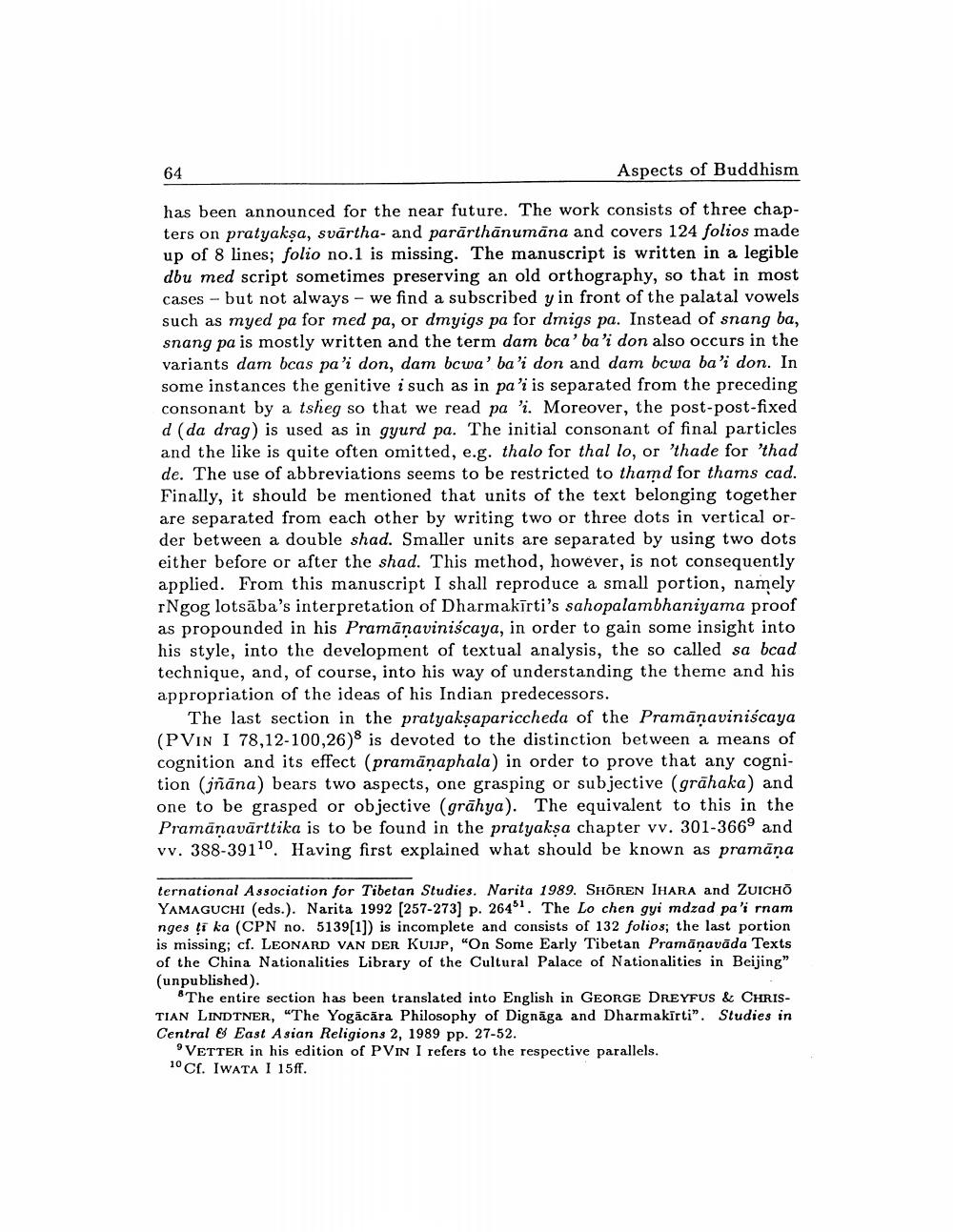Book Title: Rngog Lotsaba On Sahopalambhaniyama Proof In Dharmakirtis Pramanaviniscaya Author(s): Helmut Krasser Publisher: Helmut Krasser View full book textPage 2
________________ 64 Aspects of Buddhism has been announced for the near future. The work consists of three chapters on pratyakşa, svārtha- and parārthanumāna and covers 124 folios made up of 8 lines; folio no.1 is missing. The manuscript is written in a legible dbu med script sometimes preserving an old orthography, so that in most cases - but not always - we find a subscribed y in front of the palatal vowels such as myed pa for med pa, or dmyigs pa for dmigs pa. Instead of snang ba, snang pa is mostly written and the term dam bca' ba'i don also occurs in the variants dam bcas pa'i don, dam bcwa' ba'i don and dam bcwa ba'i don. In some instances the genitive i such as in pa'i is separated from the preceding consonant by a tsheg so that we read pa 'i. Moreover, the post-post-fixed d (da drag) is used as in gyurd pa. The initial consonant of final particles and the like is quite often omitted, e.g. thalo for thal lo, or 'thade for 'thad de. The use of abbreviations seems to be restricted to thamd for thams cad. Finally, it should be mentioned that units of the text belonging together are separated from each other by writing two or three dots in vertical order between a double shad. Smaller units are separated by using two dots either before or after the shad. This method, however, is not consequently applied. From this manuscript I shall reproduce a small portion, namely rNgog lotsāba's interpretation of Dharmakīrti's sahopalambhaniyama proof as propounded in his Pramāņaviniscaya, in order to gain some insight into his style, into the development of textual analysis, the so called sa bcad technique, and, of course, into his way of understanding the theme and his appropriation of the ideas of his Indian predecessors. The last section in the pratyaksapariccheda of the Pramāņaviniscaya (PVIN I 78,12-100,26) is devoted to the distinction between a means of cognition and its effect (pramānaphala) in order to prove that any cognition (jñāna) bears two aspects, one grasping or subjective (grāhaka) and one to be grasped or objective (grāhya). The equivalent to this in the Pramāņavārttika is to be found in the pratyakşa chapter vv. 301-366o and vv. 388-39110. Having first explained what should be known as pramāna ternational Association for Tibetan Studies. Narita 1989. SHÖREN IHARA and ZUICHO YAMAGUCHI (eds.). Narita 1992 (257-273) p. 264". The Lo chen gyi mdzad pa'i rnam nges di ka (CPN no. 5139[1]) is incomplete and consists of 132 folios; the last portion is missing; cf. LEONARD VAN DER KUIJP, "On Some Early Tibetan Pramāņavāda Texts of the China Nationalities Library of the Cultural Palace of Nationalities in Beijing" (unpublished). The entire section has been translated into English in GEORGE DREYFUS & CHRISTIAN LINDTNER, "The Yogācāra Philosophy of Dignāga and Dharmakīrti". Studies in Central & East Asian Religions 2, 1989 pp. 27-52. VETTER in his edition of PVIN I refers to the respective parallels. 10 Cf. IWATA I 15ff.Page Navigation
1 2 3 4 5 6 7 8 9 10 11 12 13 14 15 16 17 18 19 20 21 22 ... 26
